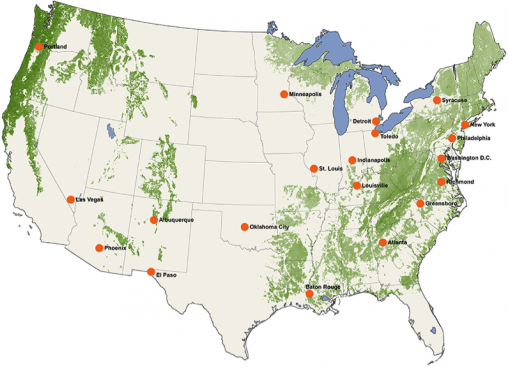Tree Hardiness Zones
Hardiness zones, defined as the average annual minimum temperature in which a plant can grow, are the current standard for arborists and gardeners to guide tree selection. Urban trees provide a myriad of services, including the ability to effectively mitigate the urban heat island effect through shading and evapotranspiration. With anthropogenic warming, hardiness zones are shifting northward over time, causing tree species to lose adaptation to parts of their historical range. As temperatures rise, some species of tree will no longer remain adapted to their urban settings. For the 50 most populous metropolitan statistical areas (MSAs), we are determining decadal hardiness zone shifts and how the associated changes in tree species distribution influence urban tree selection. Our ultimate goal is to assist cities in selecting suitable trees for changing climatic conditions.
Publications
“Climate adaptation in cities: What trees are suitable for urban heat management? ”
Lanza, Kevin, Stone, Brian. 2016. “Climate adaptation in cities: What trees are suitable for urban heat management?” Landscape and Urban Planning, 153: 74-82.
Urban Climate Change
How rapidly are large cities in the United States warming? This question is important for two reasons. First, extreme temperatures are responsible for more annual fatalities than all other forms of extreme weather combined, including earthquakes, tornadoes, and hurricanes. In a warming world, the public health threats of extreme heat are expected to intensify. Second, annual analyses of mean global temperature change omit urban weather station data, as urban temperature trends are known to reflect both background warming rates and localized warming anomalies, such as the urban heat island effect. As a result, global estimates of climate change are likely to underestimate rates of warming in the very places where most of the global population now resides: cities.
Through this study, we analyzed more than five decades of meteorological observations recorded by weather stations located within and in proximity to 50 of the most populous U.S. cities to measure the rate of change in “urban heat island” intensity – localized hotspots created by urban infrastructure and waste heat emissions – in each decade between 1951 and 2006.
The results of this analysis suggest that the actual magnitude of warming in urban areas is likely to be much greater than that forecast by the Intergovernmental Panel on Climate Change (IPCC), greatly elevating the need for climate-responsive design strategies to counteract the enhanced impacts of warming in large cities.
Publications:
“Managing Climate Change in Cities: Will Climate Action Plans Work?”
Stone, Brian Jr., Vargo, Jason, & Habeeb, Dana. 2012. Managing Climate Change in Cities: Will Climate Action Plans Work? Landscape and Urban Planning, 107(3): 263–271.
“Urban Heat Management in Louisville, Kentucky: A Framework for Climate Adaptation Planning.”
Stone, Brian, Lanza, Kevin, Mallen, Evan, Vargo, Jason, Russell, Armistead. 2019. “Urban Heat Management in Louisville, Kentucky: A Framework for Climate Adaptation Planning.” Journal of Planning Education and Research, DOI: d0o.i.1o1rg7/71/00.17137974/05763X9415968X719287194214.

